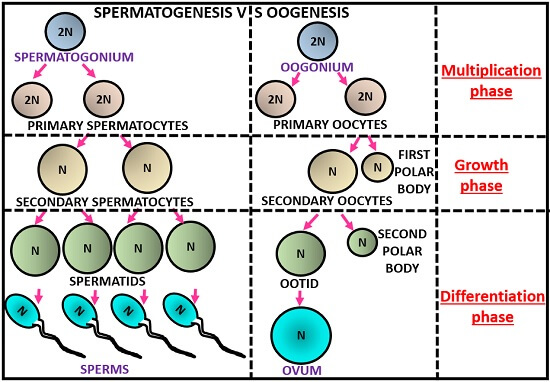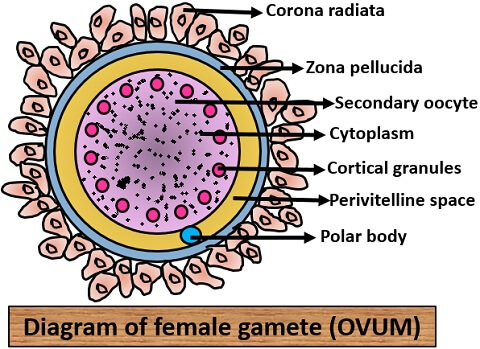The difference between spermatogenesis and oogenesis is mainly due to the following factors like the process, occurrence and the product formed after gametogenesis.
Process: The process of spermatogenesis and oogenesis is different, in which a former produce sperm cells from a spermatogonium and the latter produce ovum from an oogonium.
Occurrence: Spermatogenesis occurs inside the seminiferous tubules of a testis, whereas oogenesis occurs inside the ovary.
The sperm cells are the product formed in the spermatogenesis, which is flagellated, i.e. motile. On the contrary, ova is the product produced from the oogonia, which are non-motile. Therefore, both sperm cells and ova are structurally and functionally different from each other.
The product formed after gametogenesis: Spermatogenesis and oogenesis are the two phenomena called gametogenesis. Gametogenesis is the process of formation of both male and female gametes, i.e. sperms and ova. The formation of sperm and ovum takes place inside the male and female gonads, i.e. testis and ovary, respectively.
Content: Spermatogenesis Vs Oogenesis
- Comparison Chart
- Meaning
- Stages
- Facts
- Difference Between Sperm and Ovum
- Key Differences Between Spermatogenesis and Oogenesis
- Conclusion
Comparison Chart
| Properties | Spermatogenesis | Oogenesis |
|---|---|---|
| Oogenesis | Occurs in male | Occurs in female |
| Formation | Seminiferous tubules of testis | In ovaries |
| Process | Production of sperms from spermatogonia | Production of ovum from oogonia |
| Production of ovum from oogonia | Continuous, occurs after the puberty till death | Discontinuous, occurs after the puberty until menopause |
| Stages | All stages occurs inside the testis | Except the last stage which occurs in oviduct, all stages occurs inside the ovary |
| Sertoli cells | Found in germinal epithelium | Absent |
| Nuclear condensation | Found | Absent |
| Releasing | Sperms are released from the testis | Oocytes are released from the ovary which matures later |
| Growth phase | Too short | Prolonged |
| Food reserve | Sperm contains less food reserve | Ovum contain a lot of food reserve |
| Cytokinesis | Equal | Unequal |
| Result | Forms four motile male gametes i.e. sperms | Forms one non-motile female gamete i.e. ovum |
Meaning of Spermatogenesis
It is the reproductive stage where the formation of haploid sperms or spermatozoa occurs from a diploid stem cell called spermatogonium within a male gonad, i.e. seminiferous tubules of a testis.
Meaning of Oogenesis
It is the reproductive stage where the formation of haploid ovum occurs from a diploid stem cell called oogonium within the female gonad, i.e. ovaries.
Stages of Spermatogenesis and Oogenesis
Both the process of gametogenesis differs in their three phases, namely multiplication, growth and differentiation.

Spermatogenesis: It involves the following steps:
- First, a spermatogonium develops from the germinal epithelial lining of the seminiferous tubules that are diploid stem-cell having totipotency, i.e. self-renewing capacity.
- Spermatogonium then undergoes mitosis cell division and differentiates into the primary spermatocytes through a process called spermatocytogenesis.
- Then primary spermatocytes undergo meiosis cell division-1 and form two secondary spermatocytes.
- Secondary spermatocytes further undergo meiosis cell division-2 and form two spermatids that connect to the border of testis lumen through the cytoplasmic bridges.
- Spermatids are round, unflagellated cells that undergo maturation and form motile, haploid spermatozoa or sperms. Here, the process of formation of sperms forms spermatids is called spermiogenesis.
Oogenesis: It involves the following steps:
- First, oogonium develops from the germinal epithelium overlying the ovary that is a diploid stem-cell also having the self-renewing capacity.
- Oogonium then undergoes mitosis cell division and differentiates into the primary oocytes.
- Then primary oocytes undergo meiosis cell division-1, which arrest at diplotene stage in the childhood and puberty onwards these forms secondary oocyte and one polar body.
- Secondary oocytes further undergo meiosis cell division-2, which arrest at metaphase stage and later form ootids.
- At last, ootid when undergoes the process of fertilization it forms a non-motile, large and spherical ovum and second polar body that degenerates.
Facts about Spermatogenesis and Oogenesis
There are some facts that we must know about both the processes. So, let us discuss a few points that we should remember to know more about spermatogenesis and oogenesis.
Points to remember in Spermatogenesis:
- Spermatogenesis takes 70 days to form sperm from spermatogonium.
- A spermatogonium forms four spermatozoa or sperms.
- One primary spermatocyte will produce two secondary spermatocytes.
- The number of chromosomes is 46 in human. Therefore as there is no meiosis division in the spermatogonium, the chromosomal number will be the same, i.e. 46 in primary spermatocyte. But when primary spermatocyte undergoes meiosis cell division 1 and 2, the chromosomal number will become half, i.e. 23 in the secondary spermatocytes, spermatids and sperms.
- In one ejaculation, 200-300 million sperms produce, in which 60% are non-motile and 40% are motile.
- If there is 20million/ml of semen, then the condition will be termed as oligospermia, which causes infertility because the normal range should be within 100million/ml of semen in a male.
Points to remember in Oogenesis:
- An Oogonium produces a single ovum.
- One primary oocyte will produce one secondary oocyte and one polar body which degenerates from the ovary.
- The number of chromosomes is 46 in human, and if no meiosis division occurs in the oogonium, the chromosomal number will be the same, i.e. 46 in the primary oocyte. But, when the primary oocytes undergo meiosis cell division 1 and 2, the chromosomal number will become half, i.e. 23 in the secondary oocyte, one polar body and ovum.
- In oogenesis, 7 million primary oocytes form in the ovary of a female foetus, which regresses to 2-4 million at the time of birth. By puberty, only 40,000 primary oocytes left out and regress to 480 in number after the division in a reproductive phase of 11-50 years in females.
Difference Between Sperm and Ovum
Male gametes (sperms) and female gametes (ova) are produced after the cycle of spermatogenesis and oogenesis, respectively. Both sperm and ovum differ in many ways like their structure, motility, shape, size etc.
Structure of Sperm
Sperm is yolkless. The size of the sperm is smaller than the spermatocytes. It contains less amount of cytoplasm. Sperm is surrounded by only one plasma membrane. It consists of four parts head, neck, middle piece and tail, i.e. sperm is differentiated.

- Head: It consists of acrosome and nucleus. The acrosome is present at the tip and formed by the Golgi body and contains an enzyme called sperm lysins (digest the membrane of ovum). A non-condensed nucleus is present having no nucleoplasm.
- Neck: It consists of proximal and distal centrioles. A proximal centriole is required for the first cleavage. Distal centriole maintains the axial filament.
- Middle piece: It possesses an axial filament and mitochondria. Axial filament consists of compactly arranged mitochondria, which are approximately 25 in number and provides energy for the flagellar movement.
- Tail: It is elongated, motile and encircled by a flagellar sheath.
Structure of Ovum
It lacks a head, neck and tail, i.e. an ovum is not differentiated.

- A nucleus of an ovum is eccentric and in this nuclear condensation is present. It is bloated with nucleoplasm and called as germinal vesicles.
- Ovum lacks centrioles.
- In this, mitochondria are scattered in the cytoplasm.
- It is alecithal, i.e. an ovum will have little or no yolk.
- The size of an ovum is larger than the oocytes.
- It contains a large amount of cytoplasm.
- Ovum is encircled by the two layers, namely granulosa cells and zona pellucida.
Key Differences Between Spermatogenesis and Oogenesis
- Spermatogenesis is the production of sperms from spermatogonia in the seminiferous tubules of the testis in a male. Oogenesis is the production of the ovum from oogonia inside the ovary of a female.
- Spermatogenesis is a continuous process that occurs after the puberty till death, whereas oogenesis is a discontinuous process that occurs after the puberty till menopause.
- All stages of spermatogenesis occur inside the testis of a male, whereas the stages of oogenesis occur inside the ovaries expect for the last stage (occurs in the oviduct).
- In spermatogenesis, sperms release out from the testis, while oocytes release from the ovary that further develops in the process of oogenesis.
- Spermatogenesis results in four motile male gametes (sperms) from a spermatogonium and oogenesis results in a single non-motile female gamete (ovum) from an oogonium.
Conclusion
We can conclude that both spermatogenesis and oogenesis are the reproductive phases, which basically includes three phases like multiplication, maturation and differentiation. Multiplication is a stage, where spermatogonium and oogonium multiply by mitosis to form germ cells, i.e. spermatocytes and oocytes, respectively whose number increases after further cell divisions.
Maturation is a phase where both the germ cells grow in size. Maturation takes place when germ cells undergo meiosis, after which they form spermatids and ootids that later undergo differentiation to produce male and female gametes, respectively.
Thanks ……, your content is really nice as you have described everything so clearly that anyone can understand, so again thank you.
Information is good enough.. 🙂
This article really helped me.
We really appreciate your efforts!